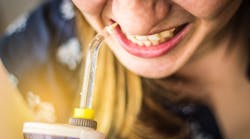Patients are always looking for alternatives to flossing, and they often ask us about water flossers. However, there seems to be a lot of confusion when it comes to the effectiveness of oral irrigation. I once worked for a dentist who told patients, “A water flosser might give the plaque a bath, but it won’t necessarily remove it.”
I’d heard other dental pros make similar comments, which left me unsure whether water flossers are a product I should recommend as a replacement or adjunct to flossing. I also didn’t learn much about oral irrigation in hygiene school. So, I decided to dig into the research to learn more.
Numerous studies from the last 50 years suggest that water flossers are more effective at removing biofilm from tooth surfaces and bacteria from periodontal pockets than string floss and manual toothbrushing, together or separately.1 A study by Goyal et. al. showed a 74.4% reduction in overall plaque and an 81.6% reduction in interproximal plaque with a water flosser compared to a 57.7% overall and 63.4% interproximal plaque reduction with string floss.2 Of course, it’s possible to attribute these differences to technique rather than product effectiveness. However, poor patient technique, compliance, and dislike of floss are reasons enough to consider alternatives.
You might also want to read: Biofilm disruption: Water flossing reimagined
What water flossing does
Water flossing does not push bacteria into the periodontal pocket, rather it removes the bacteria from the periodontal pocket and is highly effective at reducing the total aerobic flora. Braun and Ciancio found that 90% pocket penetration was achieved when probing depths were < 6 mm.3 Additionally, water flossing does not affect the epithelial lining of the pocket or show evidence of penetration into the tissue.
Attached gingiva can withstand pressure up to 160 psi for 30 seconds without irreversible damage, leading to the recommendation that 90 psi is acceptable for undamaged tissue and 50-70 psi for inflamed or ulcerated tissue.4 Bacteria removal is accomplished by the water flosser’s pulsating action.1 The incidence of bacteremia produced with water flossing is like that of other self-care exercises, such as toothbrushing and flossing.5
Water flossers tend to outperform brushing and flossing for reducing inflammation and bleeding. In a study by Al-Mubarak et. al., oral irrigation showed significant improvement in gingivitis, plaque, and bleeding on probing (BOP) compared to manual toothbrush and floss.6 Similarly, Cutler and colleagues found that oral irrigation with water, in addition to routine oral hygiene, resulted in a significant reduction in periodontal probing depths (PPD), BOP, gingival index, plaque index, and a down modulation of proinflammatory mediators.7
Several other studies have shown similar results, with a reduction in PPD and BOP whether using water alone or in conjunction with chlorhexidine or essential oils rinses.5 The American Academy of Periodontology stated in 2001 that “supragingival irrigation with or without medicaments reduces gingival inflammation beyond what is normally achieved by toothbrushing alone.”8
Perhaps the greatest benefit of water flossers is that they’re easy to use and can benefit many patient types and oral conditions. Research demonstrates benefits for individuals with orthodontic appliances, who are undergoing periodontal maintenance, who have implants, or who have diabetes.1 Oral irrigators are not technique sensitive, nor do they require special motor skills, and children as young as six are able to adequately use them.9
What hygienists should consider
All this research may lead hygienists to believe they should stop telling patients to floss and instead tell them to buy a water flosser. However, there are a few other factors to consider. A systematic review of seven studies published between 1971 to 2000 did not show a beneficial effect in the reduction of visible plaque despite the evidence of improved gingival health compared to toothbrushing alone.10
Although some studies showed improvement in plaque index parameters, others did not. Therefore, the benefit of oral irrigators may be to reduce gingivitis, regardless of whether it’s related to plaque removal.11 It’s worth mentioning that these studies are several decades old. More recent studies have demonstrated substantial plaque removal in comparison to brushing and conventional flossing methods.
Additionally, most of the research is based on one brand of water flosser—WaterPik. Considering how not all oral irrigators have the same specifications, research findings for one device may not be transferable to other designs and brands.5 With many consumers purchasing from Amazon and other companies, it’s impossible to know exactly what they’re getting without conducting more research. Additionally, there are several different tip designs for water flossers and not a lot of research about which ones are the most effective.
Water flossers are a great recommendation for most patients, particularly those who can’t floss properly or are noncompliant with flossing. There is plenty of research supporting the safety and effectiveness of water flossers, and hygienists should recommend these products to patients on a routine basis.
References
- Lyle DM. Relevance of the water flosser: 50 years of data. 2012;33(4).
- Goyal CR, Lyle DM, Qaqish JG, Schuller R. Evaluation of the plaque removal efficacy of a water flosser compared to string floss in adults after a single use. J Clin Dent. 2013;24(2):37-42.
- Braun E, Ciancio SG. Subgingival delivery by an oral irrigation device.J Periodontol.1992;63(5):469-472.
- Bhaskar SN, Cutright DE, Gross A, Frisch J, Beasley III JD, Perez B. Water jet devices in dental practice.J Periodontol. 1971;42(10):658-664.
- Jolkovsky DL, Lyle DM. Safety of a water flosser: a literature review. 2015;36(2).
- Al-Mubarek S, Ciancio S, Aljada A, et al. Comparative evaluation of adjunctive oral irrigation in diabetics. J Clin Periodontol. 2002;29(4):295-300.
- Cutler CW, Stanford TW, Abraham C, et al. Clinical benefits of oral irrigation for periodontitis are related to reduction of pro-inflammatory cytokine levels and plaque. J Clnl Periodontol. 2000:27(2):134-143.
- Treatment of plaque-induced gingivitis, chronic periodontitis, and other clinical conditions.Odontol. 2001;72:1790-1800.
- Murthy PS, Shaik N, Deshmukh S, Girish MS. Effectiveness of plaque control with novel pediatric oral hygiene need station (modified oral irrigation device) as compared with manual brushing and flossing: randomized controlled pilot trial.Contemp Clin Dent. 2018;9(2):170.
- Husseini A, Slot DE, Van der Weijden GA. The efficacy of oral irrigation in addition to a toothbrush on plaque and the clinical parameters of periodontal inflammation: a systematic review.Int’l J Dent Hyg. 2008;6(4):304-314.
- Greenstein G. Position paper: The role of supra- and subgingival irrigation in the treatment of periodontal diseases.J Periodontol. 2005;76(11):2015-2027.







